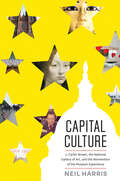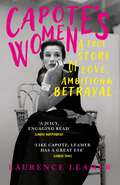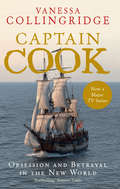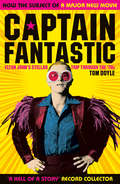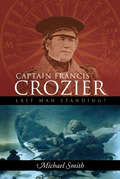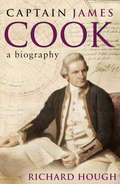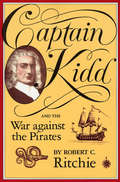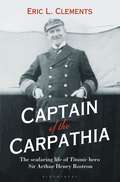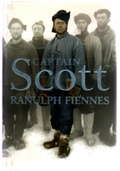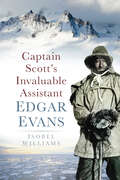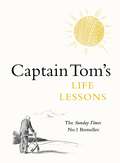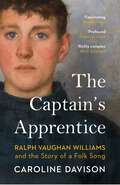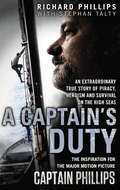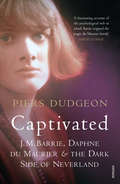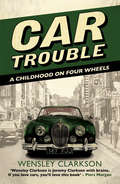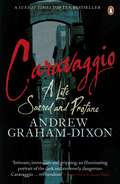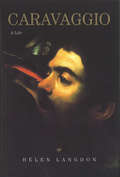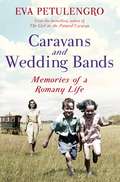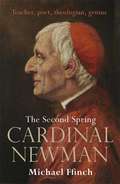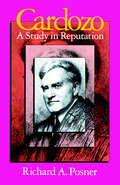- Table View
- List View
Capital Culture: J. Carter Brown, the National Gallery of Art, and the Reinvention of the Museum Experience
by Neil HarrisAmerican art museums flourished in the late twentieth century, and the impresario leading much of this growth was J. Carter Brown, director of the National Gallery of Art in Washington, DC, from 1969 to 1992. Along with S. Dillon Ripley, who served as Smithsonian secretary for much of this time, Brown reinvented the museum experience in ways that had important consequences for the cultural life of Washington and its visitors as well as for American museums in general. In Capital Culture, distinguished historian Neil Harris provides a wide-ranging look at Brown’s achievement and the growth of museum culture during this crucial period. Harris combines his in-depth knowledge of American history and culture with extensive archival research, and he has interviewed dozens of key players to reveal how Brown’s showmanship transformed the National Gallery. At the time of the Cold War, Washington itself was growing into a global destination, with Brown as its devoted booster. Harris describes Brown’s major role in the birth of blockbuster exhibitions, such as the King Tut show of the late 1970s and the National Gallery’s immensely successful Treasure Houses of Britain, which helped inspire similarly popular exhibitions around the country. He recounts Brown’s role in creating the award-winning East Building by architect I. M. Pei and the subsequent renovation of the West building. Harris also explores the politics of exhibition planning, describing Brown's courtship of corporate leaders, politicians, and international dignitaries. In this monumental book Harris brings to life this dynamic era and exposes the creation of Brown's impressive but costly legacy, one that changed the face of American museums forever.
Capital Culture: J. Carter Brown, the National Gallery of Art, and the Reinvention of the Museum Experience
by Neil HarrisAmerican art museums flourished in the late twentieth century, and the impresario leading much of this growth was J. Carter Brown, director of the National Gallery of Art in Washington, DC, from 1969 to 1992. Along with S. Dillon Ripley, who served as Smithsonian secretary for much of this time, Brown reinvented the museum experience in ways that had important consequences for the cultural life of Washington and its visitors as well as for American museums in general. In Capital Culture, distinguished historian Neil Harris provides a wide-ranging look at Brown’s achievement and the growth of museum culture during this crucial period. Harris combines his in-depth knowledge of American history and culture with extensive archival research, and he has interviewed dozens of key players to reveal how Brown’s showmanship transformed the National Gallery. At the time of the Cold War, Washington itself was growing into a global destination, with Brown as its devoted booster. Harris describes Brown’s major role in the birth of blockbuster exhibitions, such as the King Tut show of the late 1970s and the National Gallery’s immensely successful Treasure Houses of Britain, which helped inspire similarly popular exhibitions around the country. He recounts Brown’s role in creating the award-winning East Building by architect I. M. Pei and the subsequent renovation of the West building. Harris also explores the politics of exhibition planning, describing Brown's courtship of corporate leaders, politicians, and international dignitaries. In this monumental book Harris brings to life this dynamic era and exposes the creation of Brown's impressive but costly legacy, one that changed the face of American museums forever.
Capital Culture: J. Carter Brown, the National Gallery of Art, and the Reinvention of the Museum Experience
by Neil HarrisAmerican art museums flourished in the late twentieth century, and the impresario leading much of this growth was J. Carter Brown, director of the National Gallery of Art in Washington, DC, from 1969 to 1992. Along with S. Dillon Ripley, who served as Smithsonian secretary for much of this time, Brown reinvented the museum experience in ways that had important consequences for the cultural life of Washington and its visitors as well as for American museums in general. In Capital Culture, distinguished historian Neil Harris provides a wide-ranging look at Brown’s achievement and the growth of museum culture during this crucial period. Harris combines his in-depth knowledge of American history and culture with extensive archival research, and he has interviewed dozens of key players to reveal how Brown’s showmanship transformed the National Gallery. At the time of the Cold War, Washington itself was growing into a global destination, with Brown as its devoted booster. Harris describes Brown’s major role in the birth of blockbuster exhibitions, such as the King Tut show of the late 1970s and the National Gallery’s immensely successful Treasure Houses of Britain, which helped inspire similarly popular exhibitions around the country. He recounts Brown’s role in creating the award-winning East Building by architect I. M. Pei and the subsequent renovation of the West building. Harris also explores the politics of exhibition planning, describing Brown's courtship of corporate leaders, politicians, and international dignitaries. In this monumental book Harris brings to life this dynamic era and exposes the creation of Brown's impressive but costly legacy, one that changed the face of American museums forever.
Capital Culture: J. Carter Brown, the National Gallery of Art, and the Reinvention of the Museum Experience
by Neil HarrisAmerican art museums flourished in the late twentieth century, and the impresario leading much of this growth was J. Carter Brown, director of the National Gallery of Art in Washington, DC, from 1969 to 1992. Along with S. Dillon Ripley, who served as Smithsonian secretary for much of this time, Brown reinvented the museum experience in ways that had important consequences for the cultural life of Washington and its visitors as well as for American museums in general. In Capital Culture, distinguished historian Neil Harris provides a wide-ranging look at Brown’s achievement and the growth of museum culture during this crucial period. Harris combines his in-depth knowledge of American history and culture with extensive archival research, and he has interviewed dozens of key players to reveal how Brown’s showmanship transformed the National Gallery. At the time of the Cold War, Washington itself was growing into a global destination, with Brown as its devoted booster. Harris describes Brown’s major role in the birth of blockbuster exhibitions, such as the King Tut show of the late 1970s and the National Gallery’s immensely successful Treasure Houses of Britain, which helped inspire similarly popular exhibitions around the country. He recounts Brown’s role in creating the award-winning East Building by architect I. M. Pei and the subsequent renovation of the West building. Harris also explores the politics of exhibition planning, describing Brown's courtship of corporate leaders, politicians, and international dignitaries. In this monumental book Harris brings to life this dynamic era and exposes the creation of Brown's impressive but costly legacy, one that changed the face of American museums forever.
Capote's Women: A True Story of Love, Ambition and Betrayal
by Laurence Leamer'There are certain women,' Truman Capote wrote, 'who, though perhaps not born rich, are born to be rich.'These women captivated and enchanted Capote - he befriended them, received their deepest confidences, and ingratiated himself into their lives. From Barbara 'Babe' Paley to Lee Radziwill (Jackie Kennedy's sister) they were the toast of mid-century New York, each beautiful and distinguished in her own way.For years, Capote had been trying to write what he believed would be his magnum opus, Answered Prayers. But when he eventually published a few chapters in Esquire, the barely fictionalised lives (and scandals) of his closest female confidantes were laid bare for all to see. The blowback incinerated his relationships and banished Capote from their high-society world forever.In Capote's Women, New York Times bestselling author Laurence Leamer investigates the true story of the renowned author and his famous friends, weaving a fascinating tale of friendship, intrigue, and betrayal.
Captain Cook: The Life, Death And Legacy Of History's Greatest Explorer (Lyons Press Series)
by Vanessa CollingridgeA uniquely woven story encompassing three separate centuries and three different lives. Captain Cook, best known for his heroic voyages through the Pacific Ocean, is brought to life in vivid detail. We follow his humble beginnings as the son of a farm labourer, through his convention-shattering treatment of the indigenous groups he met on his travels, and then onto his final tragic voyage which signalled the end of his revered reputation. One hundred years on from the death of Cook, another great man, George Collingridge begins his own adventure. He, like Cook was oblivious to the implications his journey would have. Along the way he unfolds ancient maps, secret tales and unearths hidden lands and buried treasure. He is also said to have realised that it was not Cook who discovered Australia - it was the Portugese. This firm belief was the eventual cause of his self-destruction.Another hundred years later Vanessa Collingridge, is searching for books on her lifelong hero Captain Cook in a university library. She discovers the name of a distant cousin, George Collingridge, in a dusty card index. And so a new journey of discovery begins - in the footsteps of her hero and his nemesis.
Captain Fantastic: Elton John's Stellar Trip Through the '70s - subject of the major new movie 'Rocketman'
by Tom DoyleIn August 1970 Elton John achieved overnight fame after a rousing performance at the Troubadour in Los Angeles; over the next five years he was unstoppable, scoring seven consecutive number 1 albums and sixteen Top 10 singles in America. But behind his outré image and comedy glasses lay a desperately shy individual, conflicted about his success, his sexuality, and his narcotic indulgences. In 1975, at the apex of his fame, John attempted suicide yet, after announcing his retirement in 1977 at the age of thirty as well as coming out as a gay man, he gradually found his way back to music. Captain Fantastic is an intimate look at the rise, fall and rise again of John’s fame-and-drug fuelled decade, with a final section bringing his life up to the present.
Captain Francis Crozier: Last Man Standing?
by Michael SmithIrishman Francis Crozier was a major figure in nineteenth-century polar exploration. His voyages with Parry, Ross and Franklin lifted the veil from the frozen wastes of the Arctic and Antarctic, paving the way for Amundsen, Scott and Shackleton. The Antarctic cape named after him was immortalised in Apsley Cherry-Garrard's The Worst Journey in the World. A failed romance drove him back to the ice one fatal last time with Franklin's North West Passage expedition in 1845. All 129 men perished. Crozier took command after Franklin's death and led the courageous battle to survive in the Arctic wilderness. In the bitter life-or-death struggle, which lasted for years, some even resorted to cannibalism. But, according to legend, Crozier was the last to die – the last man standing. • Also available: An Unsung Hero: Tom Crean
Captain James Cook: A Biography
by Richard HoughIn Cook's relatively short and adventurous life (1728-79) he voyaged to the eastern and western seaboards of North America, the North and South Pacific and the Arctic and Antarctic bringing about a new comprehension of the world's geography and its people's. He was the linking figure between the grey specualtion of the early eighteenth century and the industrial age of the first half of the nineteenth century.Richard Hough's biography is full of new insights and interpretations of one of the world's greatest mariners.Image © National Maritime Museum, London
Captain Kidd and the War against the Pirates
by Robert C. RitchieThe legends that die hardest are those of the romantic outlaw, and those of swashbuckling pirates are surely among the most durable. Swift ships, snug inns, treasures buried by torchlight, palm-fringed beaches, fabulous riches, and, most of all, freedom from the mean life of the laboring man are the stuff of this tradition reinforced by many a novel and film. It is disconcerting to think of such dashing scoundrels as slaves to economic forces, but so they were—as Robert Ritchie demonstrates in this lively history of piracy. He focuses on the shadowy figure of William Kidd, whose career in the late seventeenth century swept him from the Caribbean to New York, to London, to the Indian Ocean before he ended in Newgate prison and on the gallows. Piracy in those days was encouraged by governments that could not afford to maintain a navy in peacetime. Kidd’s most famous voyage was sponsored by some of the most powerful men in England, and even though such patronage granted him extraordinary privileges, it tied him to the political fortunes of the mighty Whig leaders. When their influence waned, the opposition seized upon Kidd as a weapon. Previously sympathetic merchants and shipowners did an about-face too and joined the navy in hunting down Kidd and other pirates. By the early eighteenth century, pirates were on their way to becoming anachronisms. Ritchie’s wide-ranging research has probed this shift in the context of actual voyages, sea fights, and adventures ashore. What sort of men became pirates in the first place, and why did they choose such an occupation? What was life like aboard a pirate ship? How many pirates actually became wealthy? How were they governed? What large forces really caused their downfall? As the saga of the buccaneers unfolds, we see the impact of early modern life: social changes and Anglo-American politics, the English judicial system, colonial empires, rising capitalism, and the maturing bureaucratic state are all interwoven in the story. Best of all, Captain Kidd and the War against the Pirates is an epic of adventure on the high seas and a tale of back-room politics on land that captures the mind and the imagination.
Captain of the Carpathia: The seafaring life of Titanic hero Sir Arthur Henry Rostron
by Eric L. ClementsResponding to Titanic's distress calls in the early hours of 15 April 1912, Captain Arthur Rostron raced the Cunard liner Carpathia to the scene of the sinking, rescued the seven hundred survivors of the world's most famous shipwreck and then carried them to safety at New York. After twenty-five years at sea, the competence and compassion Rostron displayed during the rescue made him a hero on two continents and presaged his subsequent achievements.During the First World War he participated in the invasion of Gallipoli and commanded Cunard's Mauretania as a hospital ship in the Mediterranean and a troop transport in the Atlantic. As her longest-serving master he commanded that legendary vessel in transatlantic passenger service through most of the 1920s. Rostron retired in 1931 as the most esteemed master mariner of his era, celebrated for the Titanic rescue, decorated for his war service, and knighted for his contributions to British seafaring.This account uses newspaper reports, company records, government documents, contemporary publications and memoirs to recount Rostron's seafaring life from his first voyage as an apprentice rounding Cape Horn in sail to his retirement forty-four years later as commodore of the Cunard Line. Set within the context of his times and featuring particulars of the ships in which he served and commanded, this is the first comprehensive biography of Arthur Rostron before, during and after his year as captain of the Carpathia.
Captain of the Carpathia: The seafaring life of Titanic hero Sir Arthur Henry Rostron
by Eric L. ClementsResponding to Titanic's distress calls in the early hours of 15 April 1912, Captain Arthur Rostron raced the Cunard liner Carpathia to the scene of the sinking, rescued the seven hundred survivors of the world's most famous shipwreck and then carried them to safety at New York. After twenty-five years at sea, the competence and compassion Rostron displayed during the rescue made him a hero on two continents and presaged his subsequent achievements.During the First World War he participated in the invasion of Gallipoli and commanded Cunard's Mauretania as a hospital ship in the Mediterranean and a troop transport in the Atlantic. As her longest-serving master he commanded that legendary vessel in transatlantic passenger service through most of the 1920s. Rostron retired in 1931 as the most esteemed master mariner of his era, celebrated for the Titanic rescue, decorated for his war service, and knighted for his contributions to British seafaring.This account uses newspaper reports, company records, government documents, contemporary publications and memoirs to recount Rostron's seafaring life from his first voyage as an apprentice rounding Cape Horn in sail to his retirement forty-four years later as commodore of the Cunard Line. Set within the context of his times and featuring particulars of the ships in which he served and commanded, this is the first comprehensive biography of Arthur Rostron before, during and after his year as captain of the Carpathia.
Captain Scott: Captain Scott - Mad, Bad And Dangerous To Know And Mad, Dogs And Englishmen
by Ranulph FiennesSir Ranulph Fiennes is uniquely qualified to write a new biography of Captain Scott. This is the first biography of Scott by someone who has experienced the deprivations, the stress and the sheer physical pain that Scott lived through; he has suffered all but the final tragedy endured by the much maligned Scott. He is determined to put the record straight. As well as being the definitive biography of Scott, written with the full and exclusive cooperation of the Scott Estate, this book traces the way that Scott's reputation has been attacked and his achievements distorted.'Sir Ranulph Fiennes has done Captain Scott's memory some service...he has certainly written a more dispassionate and balanced account than Huntford ever set out to do.' - Simon Courtauld, Spectator
Captain Scott's Invaluable Assistant: Edgar Evans (History Press Ser.)
by Isobel WilliamsPetty Officer Edgar Evans was Captain’s Scott’s ‘giant worker’ and his ‘invaluable assistant’. He went with Scott on both the British Antarctic Expeditions of the early 1900s – the ‘Discovery’ expedition of 1901 and the ‘Terra Nova’ expedition in 1910 – distinguishing himself on both. In 1903, with Scott, Edgar made the first long and arduous sortie onto the Plateau of Victoria Land. The journey highlighted Edgar’s common sense, strength, courage, wit and unflappability. Thus it came as no surprise when, in 1911, Edgar was chosen by Scott to be one of the five men to go on the final attempt at the South Pole. Tragically the ‘Welsh Giant’ was the first to die on the ill-fated return, and posthumously Edgar was blamed in some quarters for causing the deaths of the whole party. It was suggested that his failure was due to his relative lack of education, which made him less able to endure the conditions than his well-educated companions. Isobel Williams repudiates this shameful suggestion and redresses the balance of attention paid to the upper and lower-deck members of Scott's famous expeditions.
Captain Tom's Life Lessons
by Captain Tom MooreThe uplifting and heartwarming life lessons from a truly inspirational man, Captain Sir Tom Moore'One small soul like me won't make much difference' Captain Tom________If Captain Tom's big heart and generosity of spirit helped see us through difficult days, this was his parting gift.In Life Lessons, Captain Tom has shared all that he learned from living a full and vibrant life. With cherished anecdotes and his signature humour, these heartening life stories will teach you how to:· Be comfortable with who you are· Keep smiling through the tough times· Walk in someone else's shoes· Keep an open mind· Find your purposeFull of the wit, warmth and wisdom that made him so special, his reflections and guiding principles form a long life, well lived; Life Lessons will be a source of reassurance, hope, and encouragement for generations to come.And a reminder, whenever times are hard, that tomorrow will be a good day.________'Full of the infectious energy that inspired the nation' Daily MirrorPraise for Captain Sir Tom Moore:'A wonderful life story with lessons for us all . . . beautifully written' Daily Telegraph'Engaging . . . His upbeat nature shines through and reminds us how much worse this year would have been without him' Evening Standard'A great book' Good Morning Britain'A beautiful book. We have so much to learn from Captain Sir Tom' Chris Evans
The Captain's Apprentice: Ralph Vaughan Williams and the Story of a Folk Song
by Caroline DavisonA beautifully written exploration of the world of Edwardian folk music, and its influence on the composer Ralph Vaughan WilliamsIn January 1905 the young Vaughan Williams, not yet one of England's most famous composers, visited King's Lynn, Norfolk, to find folk songs 'from the mouths of the singers'. He had started collecting in earnest little more than a year before but was now obsessed with saving these indigenous tunes before they were lost forever. An old fisherman, James 'Duggie' Carter, performed 'The Captain's Apprentice', a brutal tale of torture sung to the most beautiful tune the young composer had ever heard.The Captain's Apprentice is the story of how this mysterious song 'opened the door to an entirely new world of melody, harmony and feeling' for Vaughan Williams. With this transformational moment at its heart, the book traces the contrasting lives of the well-to-do composer and a forgotten King's Lynn cabin boy who died at sea, and brings fresh perspectives on Edwardian folk-song collectors, the singers and their songs.While exploring her own connections to folk song, via a Hebridean ancestor, a Scottish ballad learnt as a child and memories of family sing-songs, the author makes the unexpected discovery that Vaughan Williams has been a hidden influence on her musical life from the beginning - an experience she shares with generations of twentieth-century British schoolchildren.Published for Vaughan Williams's 150th birthday in August, this evocative, sensitive look at the great composer will also be read on BBC Radio 4. 'No stone is left unturned in the meticulous gathering. Her gift is a work of love and infinite care' - KEGGIE CAREW'I thoroughly enjoyed this book, and its weaving of biography, social history and folk song.' - STEVE ROUD
A Captain's Duty: Somali Pirates, Navy Seals, And Dangerous Days At Sea (Playaway Adult Nonfiction Ser.)
by Richard Phillips8th April 2009 was just an ordinary day for 53 -year-old Richard Phillips, captain of the United States-registered cargo vessel, the Maersk Alabama, as it headed towards the port of Mombasa. Ordinary that is until, two hundred or so miles off the east coast of Africa, armed Somali pirates attacked and boarded the freighter. It was the first time an American cargo ship had been hijacked in over 200 years. What the pirates didn’t expect was that the crew would fight back, nor did they expect Captain Phillips to offer himself as a hostage in exchange for the safety of his crew - a courageous gesture that resulted in his being held captive on a tiny life-boat off the anarchic, gun-plagued coast of Somalia. And so began a tense five-day stand-off, which ended in a daring high-seas rescue by U.S. Navy SEALs. In A Captain's Duty, Richard Phillips tells his own extraordinary story - that of an ordinary man who did what he saw as his duty and in so doing became a hero. It is a thrilling true tale of adventure and courage in the face of deprivation, death threats and mock executions and also a compulsively readable first-hand account of the terrors of high-seas hostage-taking.
Captivated: J. M. Barrie, Daphne Du Maurier and the Dark Side of Neverland
by Piers DudgeonJ. M. Barrie has long been a controversial figure; as D. H. Lawrence observed in 1921, 'Barrie has a fatal touch for those he loves. They die'. The five nervous breakdowns, two suicides, one attempted suicide and numerous deaths that are associated with him blacken the reputation of a man adored by generations of children.However, what is less well known is that Barrie's malign influence grew out of his infatuation with the du Maurier family, particularly with the hypnotist, George du Maurier, creator of Svengali; with George's daughter and grandsons (models for the Darlings in Peter Pan); and with his enigmatic granddaughter, Daphne du Maurier, author of Rebecca and Barrie's final victim, whose life and work can never again be considered without reference to 'Unlce Jim'.
Car Trouble: A Childhood on Four Wheels
by Wensley ClarksonWensley Clarkson's mum and dad lived on a different planet from most parents as he grew up in post-war London in the late 1950s and '60s. His mother spent much of her time nursing a tumbler of whisky and a bottle of pills, while his father edited one of Britain's bestselling weekly newspapers.Most children were taken to playgrounds and parks to play, but Wensley was left sitting in the front seat of the family saloon car outside pubs for hours with a bottle of pop and a packet of crisps. As a result, he got a taste for driving at a dangerously early age and created his own strange motoring netherworld away from the boozy, irresponsible, childish adults he was supposed to look up to.Car Trouble presents a portrait of a middle-class boy virtually left to run his own life in one of the world's biggest cities. Yet through that neglect emerged a quick-witted survivor whose life was uniquely shaped by his childhood obsession with cars.
Caravaggio: A Life Sacred and Profane
by Andrew Graham DixonMichelangelo Merisi da Caravaggio lived the darkest and most dangerous life of any of the great painters. The worlds of Milan, Rome and Naples through which Caravaggio moved and which Andrew Graham-Dixon describes brilliantly in this book, are those of cardinals and whores, prayer and violence. On the streets surrounding the churches and palaces, brawls and swordfights were regular occurrences. In the course of this desperate life Caravaggio created the most dramatic paintings of his age, using ordinary men and women - often prostitutes and the very poor - to model for his depictions of classic religious scenes. Andrew Graham-Dixon's exceptionally illuminating readings of Caravaggio'spictures, which are the heart of the book, show very clearly how he created their drama, immediacy and humanity, and how completely he departed from the conventions of his time.
Caravaggio: A Life (Icon Editions Series)
by Helen LangdonOf all Italian painters, Caravaggio (c. 1565-1609) speaks most intensely to the modern world. His early works suggest a fascination with his own youth and sexuality and the trancience of love and beauty his later religious art speaks of violence, passion, solitude and death. Ugly, almost brutal-looking, Caravaggio was constantly embroiled in fights and entangled with the law; the prototype anti-social artist, he moved between the worlds of powerful patrons and the street life of boys and prostitutes. Helen Langdon uncovers his progress from childhood in plague-ridden Milan to wild success in Rome, and eventual exile and persecution in the South, and sets his work against the political, intellectual and spiritual movements of the day. Fully illustrated, her dramatic portrait shows Carravigio's life to be as sensational and enigmatic as his powerful and enduring art.
Caravans and Wedding Bands: A Romany Life in the 1960s
by Eva PetulengroFor Romany Eva Petulengro, marrying outside her culture was a big step to take. And now she had to adapt to living with a gorger - and her husband had to adapt to living with her! In this charming sequel to The Girl in the Painted Caravan, she describes their first eventful years of married life in Brighton, and the birth of their four children She also reveals how she became famous as a clairvoyant, the advice her clients needed, and the attack from an enraged wife who assumed her husband's meetings with Eva meant he was having an affair. In the Swinging Sixties, a sheltered Romany girl could easily find herself out of her depth, and Eva's innocence led her into some strange situations, including a narrow escape from a notorious duchess. She also weaves in the story of her wider family, from her brother Nathan's romance and the adventures of her charming brother Eddie to her aunts and cousins in Blackpool. Funny and heartwarming, Caravans and Wedding Bands is a poignant reminder of a time when life was changing irrevocably for the Romany, and yet their spirit remained the same.
Cardinal Newman
by Michael FfinchThe fascinating and insightful biography of one of the most intriguing, thoughtful and controversial figures of the 19th century.'Growth is the only evidence of life' - so said poet, academic and theologian John Henry, Cardinal Newman. Canonised in 2019 (despite having said 'I have nothing of the saint about me'), Newman was an important and controversial figure in the religious history of the 19th century.This highly lyrical and accomplished biography not only covers his religious life (he played a vital role in the Oxford Movement, and subsequently converted to Catholicism), but also places him in the context of 19th-century religious revival and changing attitudes. In addition to his sometimes controversial teachings, Cardinal Newman was also a poet who wrote the text of Elgar's The Dream of Gerontius and was responsible for the foundation of the Oratorian Order in England.Michael Ffinch shows an unusual insight into Newman's character, finding an unexpected warmth and humour in a man often thought of as cold and austere. This fascinating biography also shows a deep understanding of a church emerging from dark centuries of persecution and misunderstanding into the light of what Newman himself chose to call 'The Second Spring'.
Cardozo: A Study in Reputation
by Richard A. PosnerWhat makes a great judge? How are reputations forged? Why do some reputations endure, while others crumble? And how can we know whether a reputation is fairly deserved? In this ambitious book, Richard Posner confronts these questions in the case of Benjamin Cardozo. The result is both a revealing portrait of one of the most influential legal minds of our century and a model for a new kind of study—a balanced, objective, critical assessment of a judicial career. "The present compact and unflaggingly interesting volume . . . is a full-bodied scholarly biography. . . .It is illuminating in itself, and will serve as a significant contribution."—Paul A. Freund, New York Times Book Review
